Research Activities
Integrated Research of Cultural Heritage
We study damage factors and mechanism on cultural heritage on the basis of quantitative diagnosis and development of non-destructive techniques. As a result, we provide the proper conservation environment and preventive techniques to conserve cultural heritage.
Integrated Research of Cultural Heritage
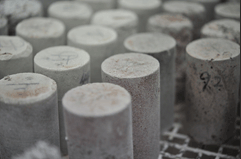 Stone cultural assets
Stone cultural assets
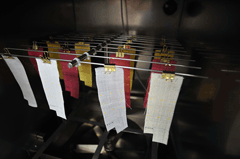 Environmental investigation
Environmental investigation
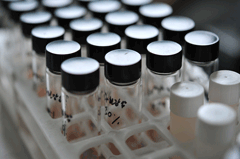 Experiment
Experiment
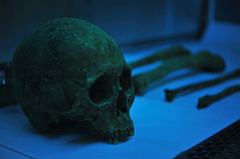 Investigation of human skeleton
Investigation of human skeleton
Conservation and evaluation research and development of stone cultural properties
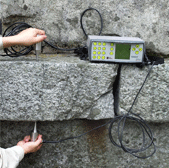
Until recently, in the fields of engineering and natural sciences, research concerning the physical evaluation of stone cultural properties had been attempted, but there were almost no non-destructive evaluation techniques available to investigate the geological properties of component materials or lithological research results, so further R&D on appropriate techniques is indispensable. Furthermore, methods of surface analysis such as ultrasonic investigation, Equo tip surface hardness analysis, and moisture meters have been developed primarily for concrete and soil substrates and cannot be directly applied to stone cultural properties whose stone types may vary and
whose surface is uneven. Therefore, the research laboratory plans to conduct research on the development of investigative and measurement techniques with a surface aeration degree appropriate for domestic stone cultural properties. Research on the verification of non-destructive evaluation methods and testing at the research site are imperative, and according to the research results, we aim to perfect our investigative and evaluative non-destructive techniques appropriate for domestic and international stone cultural properties.
Weathering Map Standards Manual
Goal :
To compile a manual prescribing standardized methods of recording and evaluating the degree of deterioration in protected ancient stone structures
Description :
1. Standardization of description methods for weathering damage
2. Research to ascertain the practical applicability of the standards developed and exploration of strategies to promote the broad use thereof.
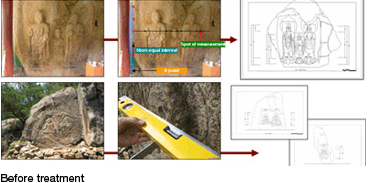
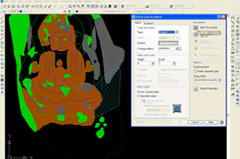 AutoCAD drawings
AutoCAD drawings
 Weathering map produced
Weathering map produced
Developing Evaluation Methods for Fillers, Surface Sealants and Adhesives
Goal :
To select conservation treatment solutions that are best adapted for use on ancient stone structures and develop standardized physiochemical testing methods
Description :
1. Petrographic analysis and determination of the degree ofweathering
2. Survey of quality testing techniques for conservation treatment solutions for stone structures and research on their physical property testing methods
3. Testing the effect of sealants on the surface resistance of stone structures, using various non- destructive methods
4. Testing the adhesive strength of epoxy resin on weathered rock
5. Determination of optimal treatment techniques according to stone type, treatment solution and degree of weathering
6. Artificial weathering tests (Freezing-thawing, acid rain spraying) and outdoor exposure tests.
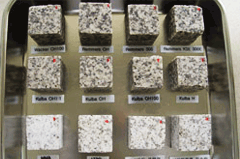 Testing of conservation materials for structural reinforcement
Testing of conservation materials for structural reinforcement
 Measurement of properties of fillers
Measurement of properties of fillers
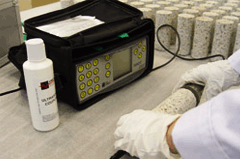 Ultrasonic speed measurements
Ultrasonic speed measurements
 Outdoor exposure testing
Outdoor exposure testing
Development of Conservation Techniques for Field Application
Goal :
To ascertain the safety and stability of conservation treatment solutions and techniques through long-term monitoring, and identify any issues
Description :
1. Testing the mechanical and physical properties of rocks before and after conservation treatment;
2. Sampling treated rocks through coring and analyzing the samples;
3. Analysis of property evaluation methods
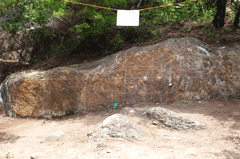 Field application I
Field application I
 Ultrasonic pulse velocity monitoring of a rock
Ultrasonic pulse velocity monitoring of a rock
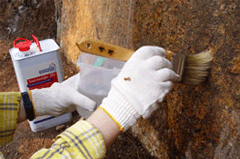 Field application II
Field application II
 Field application III
Field application III
Research Accomplishments
Research Papers
- Current Status of Government-designated Stone Cultural Heritage Monuments in Korea and Statistical Analysis Thereof, Journal of Conservation Science, 2006.
- Physical Properties of Maitreya-Sculpted Rock of Namsan Mountain, Gyeongju,' Journal of Conservation Science, 2007.
- A Quantitative Evaluation of Conservation Treatment Solutions Used with Stone Monuments of Namsan Mountain, Gyeongju,' Journal of the Mineralogical Society of Korea, 2007.
- Trends in German Cultural Heritage Research and Future Challenges,' Munhwajae Gwahak Gisul (Cultural Heritage Science), 2007.
- Standardization for Weathering Mapping of Ancient Stone Monuments,' Munhwajae Gwahak Gisul, 2008.
- A Quantitative Evaluation of Reinforcing Treatment of Granites of Namsan Mountain, Gyeongju Using Ethyl Silicate,' Journal of the Mineralogical Society of Korea, 2008.
- Preservation science research「Research on the use of preservatives on stone cultural assets – Focusing on adhesives, fillers, water repellents, and reinforcing agents-」
- Preservation science research 「An investigation of the physical property change of preservatives using artificial weathering tests」, 2008
- Preservation science research 「Environmental analysis and scientific diagnosis of the damage of the Taean Rock-carved Buddha Triad」, 2008
- Academic Journal of Cultural Heritage Conservation Science : Song Chi-yeong, Jeon Byeong-gyu, Han Min-su, Lee Jang-jon, Kim Sa-deok
- [Field study of reinforcing agent and filler applicable to stone cultural properties : initial verification using ultrasonic pulse velocity], 2009, 25(1), pp 87~100.
- Academic Journal of Cultural Heritage Conservation Science : Kim Sa-deok, Lee Myong-seong, Han Byeong-il, Lee Jang-jon, Song Chi-yeong
- [Evaluation of damages and conservation treatment of Sagokri Rock carved Standing Buddha in Jincheon] 2009, 25(3), pp 323~333.
- Academic Journal of Cultural Heritage Conservation Science : Song Chi-yeong, Han Min-su, Lee Jang-jon, Jeon Byeong-gyu, Do Min-hwan
- [Property analysis of filler compound used in the conservation treatment of stone cultural properties], 2009
- Collection of dissertations presented at the International Symposium on Cultural Heritage Conservation : Lee Jang-jon, Han Min-su, Jeon Byeong-gyu, Song Chi-yeong
- [Quantitative evaluation of effectiveness of consolidation treatment using Ethyl Silicate」
- Journal of Conservation Science : Lee Jang-jon, Han Min-su, Song Chi-yeong, Jeon Byeong-gyu, Do Min-hwan
- [Evaluation of strengthening effectiveness of Ethyl Silicate type treatment used on sandstone in Yeongyang-gun] 2009, pp 126~136.
- Journal of Conservation Science : Kim Jae-hwan, Han Min-su, Lee Jang-jon, Song Chi-yougn, Lee Jae-man, Kim Min-ji, Lee Myeong-seong
- [Field application evaluation of the conservation treatment agent based on rock quality], 2009, pp 80 ~ 91
Academic Presentation
- Diagnostics of Weathering Progress in Ancient Stone Monuments and Evaluation of Conservation Agents,'Workshop on Quantitative Weathering Diagnostics,' 2007.
- Current Status of Korea's Government-designated Stone Cultural Heritage Monuments,' Spring Joint Conference on Geological Science and Technology, 2007.
- Weathering Mapping of the Maitreya Buddha,'Fall Conference of the Korean Society of Conservation Science for Cultural Heritage, 2007.
- A Study of Adhesive Properties of Ethyl Silicate-based Reinforcing Agents Using Petrographic Samples from Namsan Mountain, Gyeongju,' 2007 'Petrographic Properties of the Maitreya Buddha of Namsan Mountain, Gyeongju and Evaluation of Degradation Progress Thereof,'International Symposium on Conservation of Cultural Heritage in East Asia, 2007.
- International Symposium on Conservation of Stone Cultural Properties 'Oral'
- Establishing Standards for Weathering Damage Mapping and Conservation Agents for Stone Cultural Heritage,' International Symposium on Conservation of Stone Cultural Properties, 2007.
- A Study of the Quantification of Conservation Agents Used for Ancient Stone Monuments,'Spring Conference of the Korean Society of Conservation Science for Cultural Heritage, 2008.
- A Quantitative Evaluation of Conservation Agents (Surface Sealants) Using Granite Samples from Namsan, Gyeongju,' Spring Conference of the Korean Society of Economic and Environmental Geology, 2008.
- The Current Status of Weathering inthe Maitreya Triad of Taean and Environment Inside the Protective Pavilion,' Fall Conference of the Korean Society of Conservation Science for Cultural Heritage, 2008.
- Quality Comparison of Conservation Agents for Ancient Stone Monuments and Their Field Application,' International Cultural Heritage Conservation Science Symposium, 2008
- Conservation Strategies for Stone Monuments of Unjusa Temple, Korea-Japan Joint Research Group 2008, 「The study on performance evaluation and field application for conservation materials in the stone cultural heritages」,2008
- 'Spring Conference of the Korean Society of Conservation Science for Cultural Heritage : Lee Jang-jon, Han Min-su, Jeon Byeong-gyu, Song Chi-yeong [Research study on the heat stability of epoxy-type fillers used in the conservation/restoration of stone cultural properties], 2009
- 'Spring Conference of the Korean Society of Conservation Science for Cultural Heritage : Song Chi-yeong, Jeon Byeong-gyu, Han Min-su, Lee Jang-jon [Research on the application of a conservation treatment agent for stone cultural properties centered on the ultrasonic measuring method], 2009
- Fall Conference of the Korean Society of Conservation Science for Cultural Heritage : Lee Myeong-seong, Kim Jae-hwan, Kim Min-ji, Lee Jae-man, Song Chi-yeong, Lee Jang-jon [Field application research on conservation treatment agents prepared for constituting the rock types and weathering properties of stone cultural properties located in Yeongyang-gun, Gyeongbuk region], 2009
- Fall Conference of the Korean Society of Conservation Science for Cultural Heritage : Kim Jae-hwan, Kim Min-ji, Lee Myeong-seong, Lee Jang-jon, Song Chi-yeong, Lee Jae-man, Han Min-su [Conservation plan research for stone cultural properties composed of volcanic tuff], 2009
- Fall Joint Conference on Geological Science and Technology: Lee Myeong-seong, Kim Jae-hwan, Kim Min-ji, Song Chi-yeong, Lee Jae-man, Lee Jang-jon, Han Minsu [Research and development of a conservation treatment system for the material and weathering properties of stone cultural properties located around Yeongyang-gun, Gyeongsangbuk-do], 2009
Research and development to improve the conservation environment of portable cultural properties

There are numerous cultural properties on display in diverse cultural property conservation facilities including museums and exhibition halls. Although these indoor environments provide relatively stable conditions compared to outdoor environments, cultural properties may be damaged by inappropriate temperature and humidity, lighting, chemical and biological pollutants, and harmful insects and mould, all of which affect the inherent conservation conditions. Therefore, by measuring various environmental factors, investigating the appropriateness of the environment, and carrying out accelerated degradation testing of major environmental factors,
we hope to continue to research environmental effects and to compile basic data for the elaboration of conservation methods appropriate to cultural properties.
Investigation of the conservation facility environment for cultural properties

1.Investigation Categories
Although there are numerous environmental factors at play, we considered the following:
- 1. Temperature
- The atmospheric temperature, expressed in ℃, ℉
- All materials undergo faster deterioration at higher temperatures than at lower temperatures.
- 2. Humidity
- Indicates the moisture level in the air and is expressed in %. Humidity can be divided into absolute humidity and relative humidity, the latter being the most commonly mentioned of the two.
- 3. Air current
- Indicates air flow indoors and is expressed in m/s.
- 4. CO2 (Carbon dioxide)
- Generally, the base concentration in the atmosphere is about 360∼400ppm. It is an indicator substance for indoor air pollution, and is mostly produced by people breathing, with an indoor concentration level of 1,000ppm. The high concentration level found indoors or in basements is due to poor ventilation, so the concentration can be lowered with the installation of an adequate ventilation system. The main effects of CO2 on cultural properties include the alteration of artifacts without paint or a protective coating due to the creation of carbonate, and the dissolution of marble (CaCO3) due to the formation of carbonic acid (H2CO3).
- 5. CO (Carbon monoxide)
- The normal concentration in the atmosphere is about 0.1∼0.2ppm and, like carbon dioxide, it alters cultural properties without paint or a protective coating by forming carbonate, and also affects the central nervous system by lowering the blood’s ability to transport oxygen by binding with haemoglobin in the blood. A high atmospheric concentration is usually due to poor ventilation, so adequate ventilation systems will lower the concentration.
- 6. SO2 (Sulfur Dioxide)
- This gas is generated when fuel containing oranosulphur compound is burned. It dissolves very easily in water and reacts to moisture, creating sulfuric acid (H2SO4), corroding metal materials, reacting with marble (CaCO3) to create plaster (CaSO4•2H2O), and weakening the tensile strength of paper or fabric. When a person is exposed to sulfur dioxide, the eyes, nose, and respiratorytract become irritated and exposure can result in chronic illness including pneumonia and bronchitis.
- 7. NOx (Nitrogen Oxides)
- There are many different types of nitrogen oxides, but the ones dangerous enough to cause problems in the atmospheric environment are nitrogen monoxide (NO) and nitrogen dioxide (NO2), and these are commonly identified as nitrogen oxides (NOx). Nitrogen monoxide dissipates in the air through direct oxidation or by reacting with ozone, turning into nitrogen oxides. Nitrogen oxides also react with moisture in the air to produce nitric acid, weakening the material of cultural properties, especially with regard to discoloration. Generally, nitrogenmonoxide and nitrogen oxides do not exist exclusively, but coexist commonly, and when there is a high concentration of the two, the eyes and respiratory tract can be irritated, causing coughing, headaches, and dizziness.
- 8. HCHO (Formaldehyde)
- It is found in various construction material sealants or adhesives and for this reason has a high indoor concentration. Being a reductant that is very chemically strong, it can easily form a polymer with various types of materials, and even a small amount can cause irritation to the eyes, nose, and respiratory tract. With sufficient operation of a ventilation system, however, the concentration can be lowered.
- 9. O3 (Ozone)
- Ozone is created when oxygen is discharged into dry air, and due to its extremely strong oxidizing power, it alters cultural properties by penetrating cellulosic materials, paints, or dyes, and long-term exposure to even a very small amount of ozone can cause damage to the lungs.
- 10. H2S (Hydrogen sulfide)
- H2S reverts oxides and causes oxidation in the air, changing to sulphur dioxide or sulphate. This compound corrodes silver or gold material and irritates the eyes, nose, and respiratory tract, causing great discomfort and, due to the pungent smell, even a (very) small dose can harm visitors.
- 11. Dust (Particulates)
- Referring to fine solid or liquid matter suspended in the atmosphere, particulates include dust, exhaust, soot, and water drops. The level of particulates inside buildings can be elevated by dust from the floor, soot from the combustion of fuel or smoking, and dust brought in from outside. Particulates can cause discoloration and alteration by adhering to the surface of the cultural properties and reacting with moisture.
2. Investigation Method
For the research area, a place with a consistent flow of air where uniform concentrations could be measured was selected, with minimal disruption to the viewing of the cultural assets. In the case of the exhibition hall, areas where cultural properties made from metal, fabric, and paper materials, which are greatly affected by pollutants, are located, and the lobby area where the heaviest crowding occurs, were selected and investigated on weekdays, holidays, and days on which the museum was closed. In addition, if the exhibition hall or museum was a multi-story building, more than one exhibition room was selected so that the characteristics of each floor could be determined.
In the case of museum storage, each location was investigated over a period of 24 hours and patterns of environmental change were analyzed.
Research on material damage caused by gas-phase contaminants
Research Aims
To verify the suitability of a facility and the influence of harmful environmental factors on the selected portable cultural properties.
To provide scientific evidentiary data for the creation of guidelines on management of the conservation environment of portable cultural properties.
Research Methodology
- Investigation and analysis of bibliographic data
- Investigation and analysis of domestic and international conservation standard references
- Analysis of the actual status data on the environment of current conservation facilities in the country
- Analysis of data on the material damage caused by gas-phase contaminants
- Selection of test conditions and representative subject
- Application of various concentrations of gases in a realistic conversation environment
- Selection of representative subjects sensitive to the damage caused by harmful gases
- Construction of equipment for evaluating the deterioration of cultural properties caused by harmful gases
- Verification of temperature and humidity, and development of preliminary tests of harmful gas concentration.
- Selection of damage assessment categories and subjects
- Selection of damage assessment categories based on the deterioration index
- Selection of a subject that represents each material
- Environment exposure test and damage measurements
- Exposure test based on the conditions of temperature, humidity, and harmful gas concentration
- Measurement of damage caused by materials such as fabric, paper, and metal
- Analysis and interpretation of the measured data
- Investigation and identification of damage characteristics based on materials of cultural properties
- Determination of safe concentrations according to materials of cultural properties
 Evaluation of material damage after exposure to a harmful environment (Physical changes)
Evaluation of material damage after exposure to a harmful environment (Physical changes)
 Evaluation of material damage after exposure to a harmul environment (Optical changes)
Evaluation of material damage after exposure to a harmul environment (Optical changes)
 Assessment of damage to materials after exposure to indoor atmosphere and pollutant gases (Surface changes)
Assessment of damage to materials after exposure to indoor atmosphere and pollutant gases (Surface changes)
Statistical research and development of ancient hereditary resources
The statistical research and development of ancient hereditary resources is a field of natural science that attempts to investigate and reveal the anthropological origins and migration route of the Korean people. By carrying out molecular genetics research on the ancient human skeletons excavated in Korea and the surrounding northeast Asian countries based on the already exisiting archaeological, historical, and anthropological research findings related to the origins of the Korean people, this research program aims to secure scientific evidence concerning the ancient history of Koreans. Moreover, by analyzing the kinship and gender of the human skeletons excavated from archaeolo-gical sites, we hope to establish fundamental scientific data to improve our understanding of ancient burial traditions.

Securing of fossil materials (Ancient human skeletal remains and animal bones) excavated from Korea and Asia
The program not only involves the examination of human skeletons already in our possession but also those currently being excavated and retrieved in Korea as well as Mongolia, Russia, and central Asia, where there are close ties to ancient Korean peoples. It is a set rule that excavated human remains are retrieved during the early stages of excavation and stored in a separate storage facility to assure their systematic management.
Excavated human skeletal remains
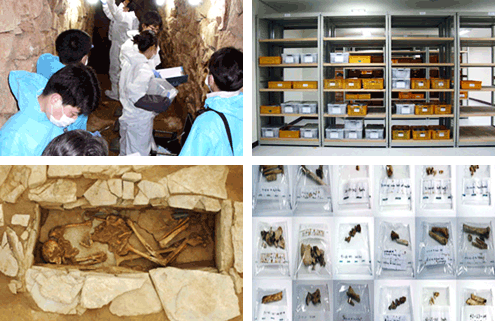
Excavation of Ancient Human Skeletons and Gathering of Samples
Skeletal remains unearthed from an ancient archaeological site may be subjected to various analytic procedures, from physical anthropological analysis to molecular genetic analysis and osteochemical analysis. When a skeleton requires ancient DNA analysis, samples must be handled with extreme care to avoid the contamination of DNA throughout the entire process, from excavation to the lab stage. To protect skeletal samples from external sources of contamination, all those who handle them wear protective clothing, conductive shoes, dust mask and biohazard autoclave gloves. Meanwhile, to gather information needed to ascertain that there was no contamination of DNA occurred during the process of excavation and collection of skeletal samples, tissue samples for DNA test (oral epithelium cells) are obtained from all participants (Only those who provide written consent). The collection of human skeletons begins with the skull, with the foot bones gathered the last. When this cannot be done due to the difficulty of fully accessing the skeleton, the collection is done from the outermost section (near the entrance point of a tomb or pit, to move on gradually inwards. When the skeletal remains belong to more than one person, samples are collected according to the order in the coding system used in forensic anthropology, and logged also according to the same order. Human skeletons are held in a specially-designed case, and ambient humidity inside the case is kept below 30% with the help of a humidity controlling agent. Staff’s contact with the skeleton collection is kept to a minimum, and their cases are locked to prevent unauthorized approach. All incoming and outgoing skeleton samples are recorded, as well as the remaining quantities of samples at given moments.
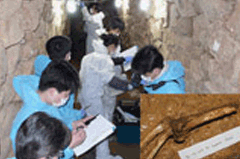 1. Collection ⁄ Excavation
1. Collection ⁄ Excavation
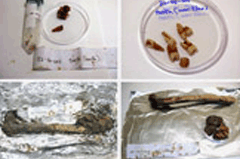 2. Removal of contaminants
2. Removal of contaminants
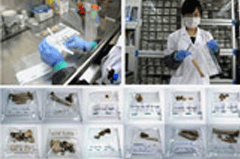 3. Storage
3. Storage
Precautions for the collection of excavated human skeletal remains from a burial site.
The Japanese carried out repair works three times during this period, removing the moss from stone surfaces with steam in 1933 and 1945.
- Photography
- - The following high-resolution photos must be taken: photographs of the burial scene including the excavation site environment; photograph of the burial site with the exposed skeleton, and photographs from which the specimen number and skeleton location can be compared.
- Prevention of contamination by those working onsite
- - Staff handling specimens requiring DNA analysis must wear sterilized gloves (Latex/natural rubber material), a sterilized mask, and arm covers. They must be careful not to speak in the direction of the specimen and no smoking should be allowed in the vicinity.
- Rapid retrieval
- - Human skeletons exposed to the atmoshphere are most vulnerable to contamination and thus require rapid collection and storage procedures.
- We recommend that a relevant professional analyst accompany staff during the collection of the specimen, if at all possible.
- - For DNA analysis and the interpretation of results, the site observation and excavation location is critical; therefore the remains should be collected by the least number of professional staff possible.
- Removal of pollutants
- In removing soil and other contaminants from the skeletal specimen, water should not be used and, since hardening facilitated by moisture can render DNA analysis impossible, it is crucial to store remains properly as they are excavated.
- Storage and transportation of the specimen
- - Use a sterilized tube (50ml test tubes), sterilized paper or plastic bags and make sure to label with the excavation site, specimen details (Specimen number, location, date, and other notes), and collector’s name before sealing. This storage method should be used prior to moving the specimen to the lab for analysis, and after its initial collection the specimen should be kept from coming into contact with air.
Ancient DNA molecular genetics research
Purpose of ancient DNA molecular genetics research
- To investigate and reveal the origins of the human species and the migration route of the population
- To analyze matriarchical ancestry through the analysis of mitochondrial DNA
- To analyze patriarchical ancestry through analysis of the Y-chromosome
- Genetic analysis of human remains excavated from a tomb
- Determination of gender and personal characteristics
- Determination of kinship and community relationships
- Investigation of ancient microorganisms and their relationship with diseases
- Investigation and identification of burial site environments
- Research of health status through the movements of microbes
- Analysis of excavated animal and plant remains
- Differentiation between animals and plants as well as their relationship to current species
- Investigation and identification of the evolution of dietary habits, livestock husbandry, farming practices, and animal/plant usage.
Ancient DNA analysis lab
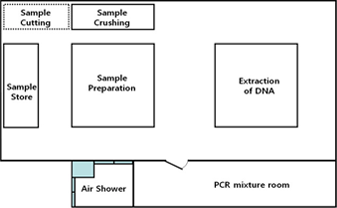
For the analysis of ancient DNA, special precautions must be taken to eliminate contamination by those handling the samples and the external environment, so creating a lab that can prevent such contamination is important. The DNA extraction lab for excavated human remains should be set apart from the regular DNA analysis lab, and must be set apart from labs that carry out DNA amplifi-cation or cloning.
Extraction and analysis of ancient DNA
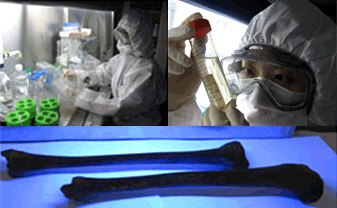 1. DNA extraction
1. DNA extraction
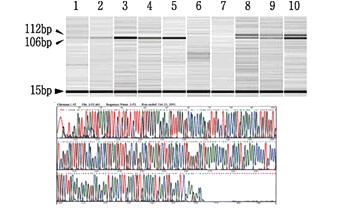 2. DNA expansion & sequencing
2. DNA expansion & sequencing
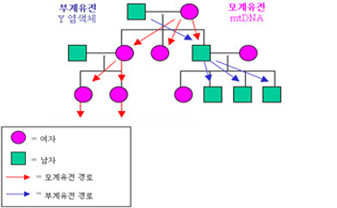 3. Phylogenetic Analysis
3. Phylogenetic Analysis
Strategies for conducting phylogenetic R&D on ancient genetic resources
| Strategic | Core goals & items | Final accomplishments |
|---|---|---|
| Collection | Monitoring of the excavated condition of the organic remnants of ancient human skeleton; and acquisition of specimens → Collection of archeological organic remnants |
Construction of ancient genetic database |
| Infrastructure | Acquisition of experts in ancient genetic matters and related equipment → Construction of research centers that meet the international standards |
Expansion of assis-tance for the analysis of excavated archeological data |
| Technology | Development of analytical technology related to ancient genetic matters (Establishment of its own TRM) → Accumulated DNA analysis technology related to ancient DNA and lead research → Seek collaboration research (Archeological research of Hamansanseong Fortress) |
Seek collaboration research (Archeological research of Hamansan-seong Fortress) |
| Information | Use the moist advanced bio information technology → Construct a research information system related to ancient genetic resources |
Verify the generic origin of Korean ethnicity |
| Fusion | Conduct fusion research with humanities (Archeology, Humane, History) → Conduct collaboration research with departments and various academic fields |
Verify the genetic origin of Korean ethnicity (R&D) |
Research and development of techniques for analyzing and interpreting archaeological specimens

This scientific study is designed to investigate and reveal lifestyles and migration routes through the natural scientific investigation and analysis of ancient cultural properties such as artifacts excavated in Korea and surrounding locations. By creating a database of the earthenware, pottery, ainted, and metal artifacts excavated at archaeological sites, we hope to develop our knowledge of characteristics that can identify objects as belonging to home or commercial environments so that we can establish a tracking system between cultures by classifying manufacturing techniques and migration routes.
Investigation of cultural information factors
Among ancient ruins and artifacts, certain factors can be identified from which information about the lifestyles and technical knowledge of an ethnic group can be extracted. We attempt to analyze ancient earthenwares, woodworks, soil, and fabrics so that the lifestyles and technological advances of a given location and time period can be established.
 Jangdae-ri Ruins in Ochang-eup, Chungcheongbuk-do
Jangdae-ri Ruins in Ochang-eup, Chungcheongbuk-do
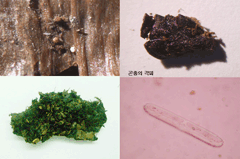 Environmental information research of the site based on investigation of the organisms and microorganisms present at the site
Environmental information research of the site based on investigation of the organisms and microorganisms present at the site
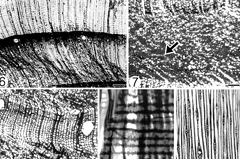 Research of anatomical properties of excavated lumber
Research of anatomical properties of excavated lumber
 Research of ancient dyeing techniques – clothes excavated at the grave of the Son clan grave of Gurye
Research of ancient dyeing techniques – clothes excavated at the grave of the Son clan grave of Gurye
 Analysis of excavated earthenware
Analysis of excavated earthenware
Research on the interpretation methodology of ethnic cultural information
The principal goal of our research on the interpretation methodology for ethnic cultural information is to develop a system that will enable investigation of the characteristics and migration routes of ethnic cultures more objectively and efficiently. To that end, we plan to carry out consistent artifact analysis, develop and implement a database program for the collection and management of artifact data, and carry out the development of statistical analysis techniques that can deduce significant cultural information through the analysis of the stored data as a whole. By 2013, we plan to have established a system equipped not only with a database for earthenware, pottery, bronze, and glass artifacts, but also with the capacity to undertake statistical analysis.
Collection and management of the analysis data
 Development of a collection and management program for artifact analysis data
Development of a collection and management program for artifact analysis data
 Development of statistical data analysis techniques
Development of statistical data analysis techniques
 Deduction of cultural information – categorization of glass by location based on the fusing agent
Deduction of cultural information – categorization of glass by location based on the fusing agent
Standardization of analysis techniques and development of new techniques
In the research of ancient pottery and earthenware, production techniques and production area research based on the analysis of microingredients, primary composition, and mineralogical properties will be undertaken. Furthermore, we hope to construct statistical interpretive techniques for the comprehensive comparative interpretation of the analysis data and analysis results obtained from various sites. Furthermore, analysis of ancient paint has mainly been carried out with the purpose of investigating and revealing the component materials; however, with the advancement of analytical devices, we are striving to establish non-destructive techniques and interpretive guidelines through the use of cutting-edge analysis instruments.
Middle Road Map
Creation of an interpretive standard for calcinate environments using the middle road map characteristics and XRD pattern
| 2012 | Research on a standard for calcinate environments using composition characteristics and XRD pattern |
|
|---|---|---|
| 2011 | Cross-section for the estimation of earthenware’s calcinate temperature |
|
| 2010 | Analysis of physicochemical characteristics of the earthenware Production of standard specimen |
|
Proposal of non-destructive technique of analyzing data on ancient paints, using PXRF
| 2015 | Research based on PXRF analysis of paint properties |
|
|---|---|---|
| 2014 | Research based on PXRF analysis of the characteristics of paint applied to earthen walls |
|
| 2013 | Research on ancient and modern mineral paint’s X-ray penetration movement |
|
Conversion of analysis data on paints from the ancient to modern periods into a database and establishment of a development plan for the paint movement program
| 2015 | Paint movement program for ancient to modern period paints |
|
|---|---|---|
| 2014 | Analysis of ancient to modern period paint as well as exploration of preprocessing method |
|
| 2009 ~2013 |
Allocation of ancient to modern period paint specimen and fundamental analysis |
|
Conservation of organic cultural properties / Research and development of storage techniques
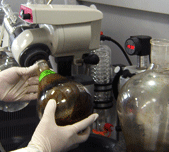
Currently in Korea, in order to prevent damage to organic cultural properties by insects and microorganisms, various methods including environmental controls, fumigation, and insect controlling preservatives are used. However, gases such as methyl bromide used during such procedures have been designated as hazardous materials for the environment, and the harmful effects of sublimate sterilization and mycostats such as paraformaldehyde and thymol on the environment, cultural properties, and the human body have been previously documented. Therefore, with this international research and development project, we hope to develop safe,
eco-friendly treatments for the conservation of organic cultural properties by allocating components from natural resources and by observing the effects of biologically active impediments, as well as the material stability and other harmful effects on cultural properties.
Development process of biologically active impediments from natural substances
Selection of natural substances and extraction and refinement of active ingredients
1. Selection of candidates for the extraction of natural substances using wild plant resourcesand traditional herbal medicines
2. Solvent extraction of natural substances and subdivision
3. Separation of active ingredients through purification of the extracted and refined substances
Exploration of the antifungal and insect-proof effects of the main ingredients
1. Screening of the biological impediment effects of the natural substance ingredient
2. Activation of antifungal (Paper disk soaking method) and insect-proof (Measurement of toxicity on contact) effects
Evaluation of material’s safety for the human body and the environment
1. Research on chemical reaction and safety of the active ingredients
2. Research on material safety with regard to organic cultural properties, safety with regard to human contact, particularly the respiratory tract, and environmental safety
Example of insect inhibitor/antifungal product developed specifically for the conservation of cultural properties
Based on research on the chemical and physiological properties of natural ingredients extracted from herbs traditionally used to preserve artifacts, we attempted to shed scientific light on the wisdom of traditional knowledge and to promote the development of insect repellent / antifungal products which do not have any harmful effects on cultural properties. As a result of this effort, in 2000 we were successful in extracting insect repellent/antifungal ingredients that would not have any harmful effects on the conservation of cultural properties from a traditional herbal medicine, and we became the first researchers to develop an insect repellent/antifungal product specifically for cultural properties. The result of this research was a patent application in 2001 and, as of now, we have completed the various stages of product development for the effective conservation and management of paper and fabric cultural properties. We completed the merchandizing of our products in 2003 and finalized the patent in 2004 (No. 0421538), leading research on the conser-vation of protection of cultural properties from biological damage.

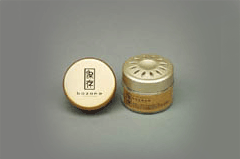 Natural air freshening using penetratable filters
Natural air freshening using penetratable filters
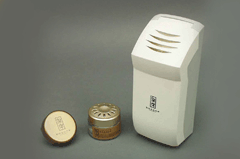 Artificial air freshening through installed fan
Artificial air freshening through installed fan


